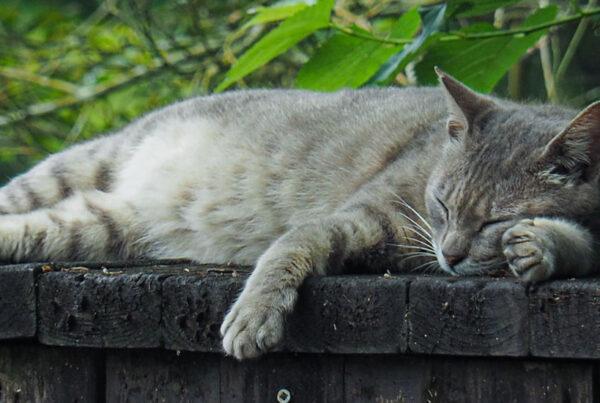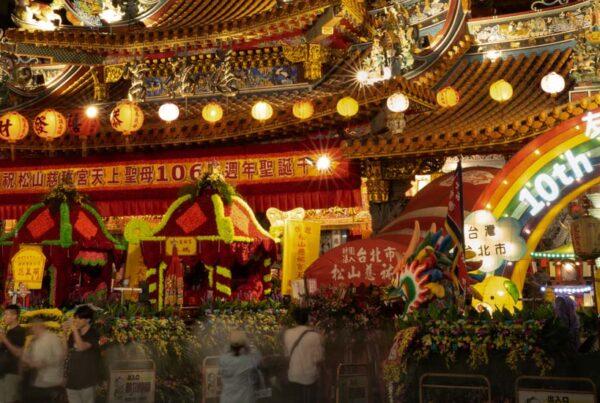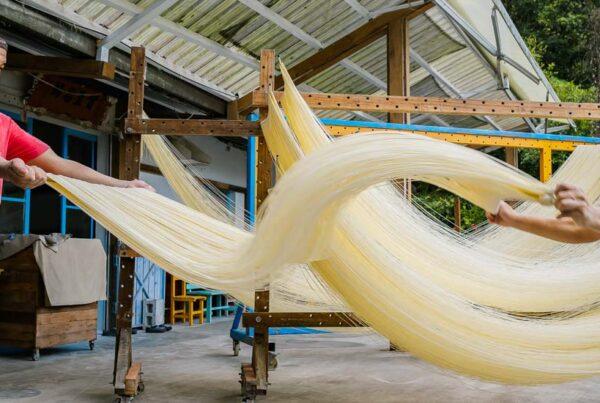A Day-Tripper’s Guide to Getting the Most Out of Hsinchu City
TEXT / AMI BARNES
PHOTOS / RAY CHANG, VISION
With easy rail and road connections, the northwestern coastal municipality of Hsinchu is a convenient day-trippable distance from Taipei. Visitors can spend a pleasant morning strolling its streets hunting for history, an afternoon cycling towards sunset, and an evening attending to both spiritual and bodily needs with a visit to a market-ensconced temple.
Hsinchu is a city that has wholeheartedly embraced modernity. Homegrown international tech companies have turned its sprawling, 1,400ha science park into a technology hub of global importance, while the city’s many universities have given it an injection of youth culture and a bounty of inexpensive eateries. Standing in stark contrast to this modern image are the various living traces of the city’s deep history as well as easily accessible natural spaces like the scenic 17km Coastal Bikeway. When taken together, these elements form a strong foundation for a rewarding and multifaceted day out.
Central Hsinchu
Just over an hour by Express train from Taipei (90 min. by local train), Hsinchu Railway Station is the ideal jumping-off point for a foray into this oft-overlooked and underappreciated city. The station, which celebrated its centenary in 2013, is Taiwan’s oldest surviving station building still in use. It was designed by Matsugasaki Tsumunaga, a German-trained Japanese architect whose Baroque-infused flourishes added a touch of European style to structures throughout Taiwan. Most of his creations have been lost to time and modernization, and today the iconic The Red House in Taipei’s Ximending district (co-designed with a second Japanese architect) and this station are all that remain.


East Gate
Turning left out of the station, a 200-meter wander west along Linsen Road brings you to the southern end of Hucheng He Riverside Park. This oasis of water and greenery threads its way through the heart of present-day Hsinchu City, tracing the course of the moat that once encircled the city walls. Nestled among the foliage are other remnants of historic fortifications, like the support columns for two bridges and the old East Gate (Yingxi Gate). The almost 200-year-old gate has been given monument treatment and now sits proudly on the edge of a pedestrianized plaza that can only be entered via subterranean walkways. Mirrors line the walls on one side of these tunnels, reflecting the historic stonework and brickwork left exposed, and – when school’s out – provide Hsinchu’s youth with space for practicing their dance moves.



Hsinchu Chenghuang Temple
Ever since Hsinchu became a fortified city in the 1730s, Hsinchu Chenghuang Temple (or Hsinchu City God Temple) has occupied space at its core. City God temples exist throughout Taiwan as a spiritual foil to city-level politics. Their main deity is always Cheng Huang Ye (aka the City God) – a Taoist figure whose role in the supernatural realm is akin to that of a modern-day mayor. Time has slackened such temples’ connection to politics, but they nevertheless are sustained by legions of dutiful devotees.

Over the decades, a profusion of vendors selling fried, grilled, skewered, and candied snacks has been drawn in by the inescapable magnetism that such vital religious centers seem to possess. Surrounded by these businesses, the only hints of this temple’s existence on approach are its brightly colored roofs rising above the stalls and a couple of narrow archways leading into the market/temple labyrinth interior.

Ducking through one of the entrances is like entering a self-contained parallel world. Vendors weave through the crowds with the sure-footed nimbleness of alley cats as they bear bowls of steaming noodles aloft to hungry diners, and clouds of enticingly-scented vapor waft along in their wake, mingling with the heady aroma of incense smoke billowing from the censer in the table-lined temple courtyard.

If you were hoping for calm upon stepping into the temple itself, you would be left wanting. The inside is as colorful as an explosion in a paint factory and chock-full of deities jostling for altar space. As well as the City God himself, you’ll find Taoist and Buddhist figures – Guanyin (Goddess of Mercy), the Maitreya Buddha (rotund and jovial), Yue Lao (spiritual matchmaker, aka “Old Man under the Moon”), the City God’s wife (fixer of marital issues), and plenty more. Even when Travel in Taiwan visited the temple for this article on a Monday morning, the walkways were packed with incense-toting believers seeking favor and guidance.

Local Specialties
After the excitement of the temple, it’s well worth exploring the area’s other many and varied eateries. Hoping to narrow down our selection, we picked a couple of spots most popular with local foodies. First up was Lin Family Taro Balls. This vendor sells just two items – the original taro-only version and one with melted mozzarella. Each ball is a huge nugget of doughy, deep-fried, and lightly sweetened taro mash, and be warned – they’re filling. One is definitely enough to split between two if you’re trying this snack treat out of curiosity.



Another regular feature of guides bringing people to the temple market and surrounds is Miaokou Duck Rice. Top billing on the menu goes to the dish that gave the store its name – bowls of sticky white rice loaded with tender umami cuts of duck and slivers of sweet-sharp pickles. Accompanied by a soy sauce-slathered egg and deep-fried wontons, and washed down with a bowl of pork balls in broth, this is a fulsome meal, but it would be a shame not to leave a little room for dessert.


One sweet option that won’t leave you feeling overstuffed is Guihong Fuling Cake. The confections of this vendor have a similar flavor profile to the Taiwanese ice-cream burrito. Chopped peanuts and cilantro sit on a chewy bed of white maltose taffy, all of which is encased in a crispy biscuit shell. The flavors sound unorthodox to a Western palette, but this roadside-stall operation has been in business for over six decades, so it certainly has the locals’ seal of approval.



If after this your sweet tooth remains unsated, head to the nearby Pinxin Ice Shop. A comparative newcomer to the area, Pinxin sells mounds of fruit atop hillocks of shaved ice – the perfect defense against summer’s inescapable heat.
Along the Coast
Stretching from Zhunan Coastal Park (in Miaoli County) in the south to Nanliao Fishing Harbor (Hsinchu City) in the north is the flat 17km Coastal Bikeway that hugs the coast for, yes, a full 17 kilometers. Undertaken purely on two wheels, the ride can fill the better part of a day, especially when factoring in breaks for exploration and refueling. However, if you’re seeking briefer alternatives, then either driving or catching a local train to Xiangshan Railway Station and picking up a YouBike rental bike at the station would allow you to condense the trip into a single afternoon.

Xiangshan
Not only is Xiangshan Railway Station a good jumping-off point for your ride along the Hsinchu coast, but it’s also a noteworthy destination in its own right. The original station was built in 1902, although the current building dates to a later 1928 expansion and makeover. At the time, the Japanese authorities governing Taiwan were in the midst of a massive drive to expand rail and road infrastructure, primarily to transport commodities from the south and interior to ports along the coast, where they could be loaded onto ships bound for Japan. Like many other Japanese-built structures from that era, it was constructed using local hinoki, a type of wood sourced from Taiwanese red cypress trees that’s highly prized for its durability, pleasant fragrance, and beautifully warm tones. Even if you don’t have a train to catch, you can pop in to take a seat on the wooden benches lining the waiting room and meet the station master’s cat.



Heading northwards, the next port of call for us was the Xiangshan Wetlands. This vital wetland habitat, spanning nearly 17 square kilometers from the Hsinchu-Miaoli boundary to the Keya River, was once threatened by land reclamation projects. Thankfully, local environmentalists were successful in fighting for its preservation and now the dunes, mudflats, and mangroves provide a home for a diverse array of wildlife. The wetlands’ star attraction is undoubtedly the Crab Viewing Boardwalk. Here, visitors can observe numerous crab species as well as comical-looking mudskippers. Fiddler crabs dominate the higher reaches of the foreshore, the largest among them easily fending off smaller rivals with a warning wave of a lopsided pincer, while more evenly matched opponents dance dueling circles around their burrows. Out at the boardwalk’s seaward end, tiny soldier crabs hold sway, and in contrast to their less social neighbors, they march across the flats in small, coordinated troops. So numerous are the crustaceans here that – if you sit quietly on the edge of the boardwalk – you can hear the sound of them eating.





Nanliao Fishing Harbor
The final stop on our day’s journey was Nanliao Fishing Harbor. This is right up at the northern end of the bikeway and is comprised of a working fishing harbor surrounded by the kind of amenities that have turned it into a destination popular with day-trippers and locals alike. A large grassland area – used each September as the venue for the Hsinchu City International Kite Festival – is often filled with families making use of Hsinchu’s legendarily windy conditions to practice flying their kites. Refreshments are covered in the form of a weekend market selling light bites and drinks, as well as a gathering of shipping containers that have found a second life as coffee and ice-cream stores. And as the shadows lengthen, what better way to round off the day than by joining the groups of friends and couples gathered on the Nanliao Fish Scale Steps to watch the sun plunge into the waters of the Taiwan Strait!


About the author
















